The world until yesterday: meeting the tribes of Ethiopia’s Omo Valley
Simply sign up to the Life & Arts myFT Digest -- delivered directly to your inbox.
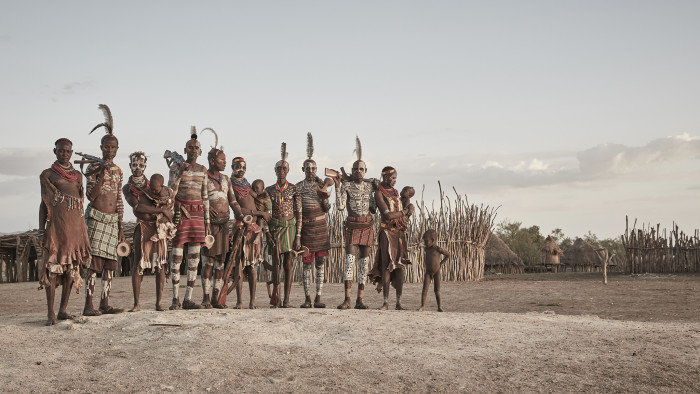
So laid-back, almost soporific, is the village, and so strikingly is everyone turned-out in their white body paint, leopard-spotted face markings, beads and bracelets, that it takes a while to notice nearly all the men are carrying AK-47s. Each one, naked but for a cloth around his waist and a single upright ostrich feather in his hair, sits on a carved wooden stool, which doubles as a pillow. Bodies are streaked in chalk-white stripes and swirls, like Day of the Dead skeletons. Some wear copper arm bracelets and others have belts recycled from the best source of metal available — spent bullet cartridges.
It has been several years since AKs replaced spears in this south-western corner of Ethiopia, says Lale Biwa, one of few Kara tribesmen able to converse in English. More status symbol than weapon, they are now practically obligatory for any young man hoping to marry. Occasionally they are deployed in skirmishes between the different tribes of the Omo Valley, Biwa says, or used to kill the huge crocodiles that thrash in the river’s chocolatey brown waters.
Here in the Lower Omo Valley, squeezed along the borders of South Sudan and Kenya, few speak Ethiopia’s national language of Amharic. Many cannot name the capital, some 350 miles to the north, as Addis Ababa.
Ethiopia has a different feel from other sub-Saharan African countries. Certainly the Ethiopians of the highlands, light-skinned and custodians of one of the world’s oldest alphabets, like to think so. Many trace their heritage to the ancient civilisation of Aksum, to King Solomon and to the Queen of Sheba.
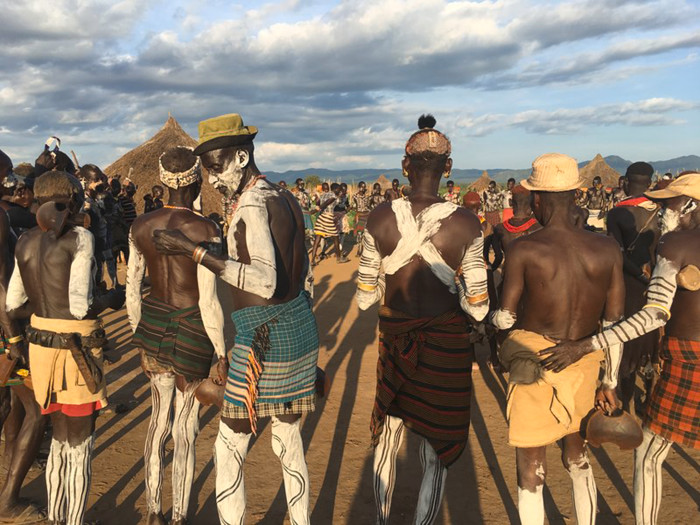
These days, the government in Addis has also set itself apart. Since the overthrow of the Marxist Derg regime of Mengistu Haile Mariam in 1991, the Ethiopian People’s Revolutionary Democratic Front has pursued a development plan modelled on the Asian tigers. Its investments in dams and roads and its creation of manufacturing jobs in garments and electronics are intended to transform a state that was once a byword for poverty and famine into a middle-income country.
In their semi-nakedness and cultural separateness, the Kara and other indigenous tribes of the Omo Valley do not fit easily into that narrative. From Addis, the thin-aired capital, with its coffee shops, monorail and dust-billowing building boom, the people in the sweltering lowlands of the Southern Nations are a world apart. A student I meet at Addis Ababa University is unsure how to describe his fellow countrymen from the south. “I hear they don’t wear clothes down there,” he says.
To get down there — really down there — takes time. We boarded a flight from Addis on a new Ethiopian Airlines route to Jinka, a town so unfamiliar to airport staff that one denied point blank there was a service to any such place. From the new runway at Jinka it was four hours’ drive towards the border with South Sudan. This was big-sky country with rolling hills and, at one point, an extraordinary cityscape of spindly towered termite mounds, veritable Burj Khalifas of the insect world.
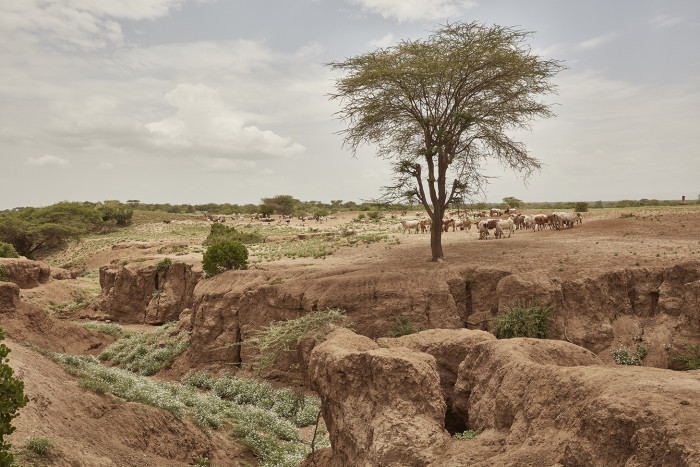
This is as far as most tourists get but we were going further. At Murulle, we boarded a boat and took to the waters of the Omo, the mightiest river in Ethiopia after the Nile, which snakes its way from the highlands for 500 miles before emptying out into Lake Turkana.
As we sped along, sending out a muddy spray, the most obvious feature of the river was its crocodiles. Hundreds of them. They were obsessively active. As the boat passed, many slithered into the water. One lunged hopefully at a grey heron as it flapped by with a squirming fish in its beak. There were a few dugout pirogues on the river, but so treacherous were the crocodiles that, in four days, we spotted not a single other person on the water.
We were travelling with Graeme Lemon, general manager of Wild Expeditions, which brings tourists to Lale’s Camp, the brainchild of Biwa. The tented camp, with its hot running water, flush toilets and safari-style luxuries, is situated on the banks of the Omo next to Dus, one of three settlements belonging to the 4,500-strong Kara community. They are one of eight main tribes living in the Lower Omo Valley.
Until recently, when Biwa teamed up with Wild Philanthropy, a two-year-old UK charity that seeks to use tourism to promote conservation, not many made it to his camp. The very few that did tended to be intrepid travellers without a big budget. Wild Philanthropy markets the experience instead to a wealthy international clientele with the aim of funnelling more money into local communities. It has helped establish a licensed tour operator in Ethiopia, Wild Expeditions, of which Biwa is a shareholder.
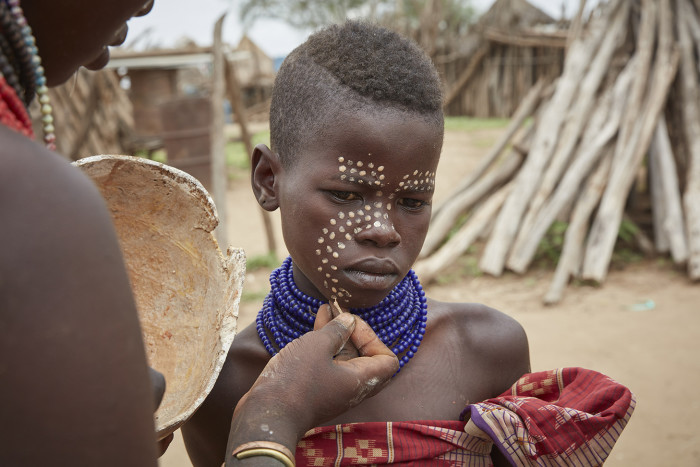
Not only does Lale’s Camp provide employment for community members, says Paul Herbertson, Wild Philanthropy’s conservation enterprise director, there are also plans to establish a vegetable farm so that villagers can improve their diet and sell produce to the camp.
Lemon has definite views about how visitors should interact with the people of the valley, especially those in this more remote part whose experience of westerners is both recent and limited. The camp sleeps a maximum of eight guests and only takes one group at a time. Probably no more than 40 people visit each year. The camp tariff includes a “village entrance fee”; Wild Expeditions also brings coffee and maize and some richer clients have made donations.
The villagers would meet us on their own terms, Lemon said. Photography was not encouraged, though it was fine to ask, so long as we accepted it if the answer was no. Our first encounter with the Kara was in Dus, their medieval-looking capital, home to about 1,000 people. It was shortly after our boat docked that we met the men sat nonchalantly on their polished stools, AKs in hand. Conversation was only possible when Biwa was there to translate and even then was not easy. Mostly we communicated with smiles and gestures, or asked simple questions about family, diet or clothing. Even asking how old someone was provoked confusion. The Kara apparently don’t keep count.
Though the communities of the Omo Valley — including the Mursi, the Dassanech, the Kwegu, the Hamar and the Nyangatom — live in close proximity, they speak different languages and practise different customs. Each meeting means learning a new greeting: “hello” in Hamar is “paiyo”. It is “hopo” in Kara and “achali” in Mursi.
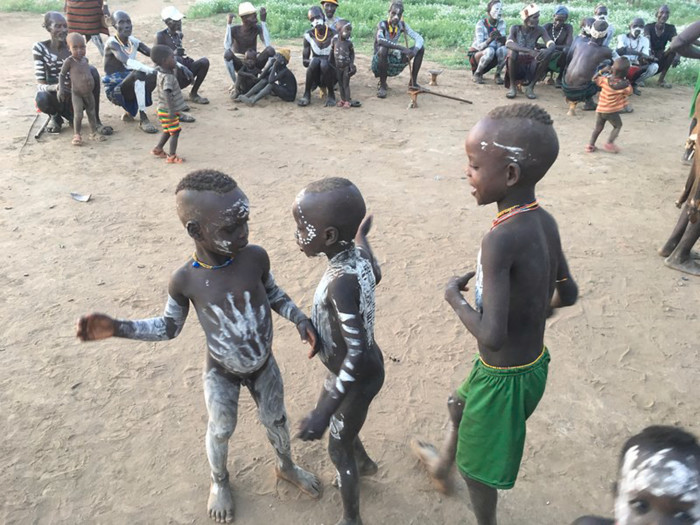
Jared Diamond, academic and author, describes in his book The World Until Yesterday the astonishing variety of practices and beliefs that existed before a uniform western lifestyle conquered the world. He explains, for example, wildly different attitudes to the elderly. In some communities, the elders’ knowledge was so revered that, when they lost their teeth, younger family members would pre-chew their food. In others, especially those constantly on the move, old people were a burden. Sometimes they were left behind in the forest to die.
Similarly, in this sub-region of Ethiopia, customs alter substantially over relatively short distances. Clothes, body paint, hairstyles, piercings and scarification marks vary. So do initiation rites and marriage customs. Some communities practise female genital mutilation, though most inhabitants of the Omo Valley — including the Kara — do not.
The women of the Mursi cut their lower lip so that, after years of stretching, it hangs down like a slack rubber band, allowing the insertion of a lip plate on special occasions. For other people, living perhaps within shouting distance, such mutilation is unthinkable. Biwa explained how God made everyone: the British, the Italians, the Germans, the Dassanech, the Nyamatom and the Kara. Then he remembered to make the Mursi, giving them a lip plate to distinguish them from the rest.
The bull jump is the Kara’s initiation rite. A row of bulls are lined up, flank to flank, and boys run naked over their backs, taking care not to slip down the cracks. The Kara carry out their ceremony only in large groups, which requires a good harvest to provide the goat meat, maize and homemade beer expected by guests.
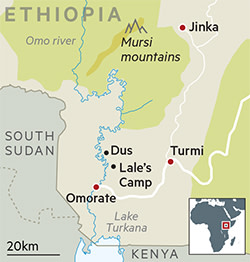
Recently, that has proved a problem. To the north, the Ethiopian government has been damming the Omo for hydroelectric power. A third dam was recently completed, lowering the water level and ending the annual flooding that has reliably enriched the soil. Harvests had been poor, said Biwa, and no bull-jumping ceremony had taken place for three years.
One late afternoon, we walked through Dus and stopped at the Ceremony House, an elders’ parliament, a structure of sun-bleached wood salvaged from the Omo and assembled like the rib-cage of a blue whale. Inside, instead of debating elders, it was raucous with bleating goats. The elders were not in attendance, Biwa explained, since, deprived of the annual floodwaters, they had moved outside the village to farm. One project that Wild Philanthropy is funding is a solar pump to help irrigate land close to the river. It is also hoping to finance a local clinic.
Customs and practices are changing fast. Turkish and Chinese companies are investing in land-hungry sugar and cotton plantations. Chinese-built roads are bringing visitors, exposing communities to tourists with money and cameras.
When we met the Mursi ourselves, we travelled three hours upriver by boat and they walked eight hours out of the “Mursi Mountains” to meet us. At first, the women shrieked when they saw images of themselves trapped on the iPhone screen. Yet, in testament to the genius of Steve Jobs, within minutes they were swiping through photographs at a rapid clip. This is one of the few corners of Africa where mobile phones are rare, but it cannot be long before they join AK-47s as a must-have item.
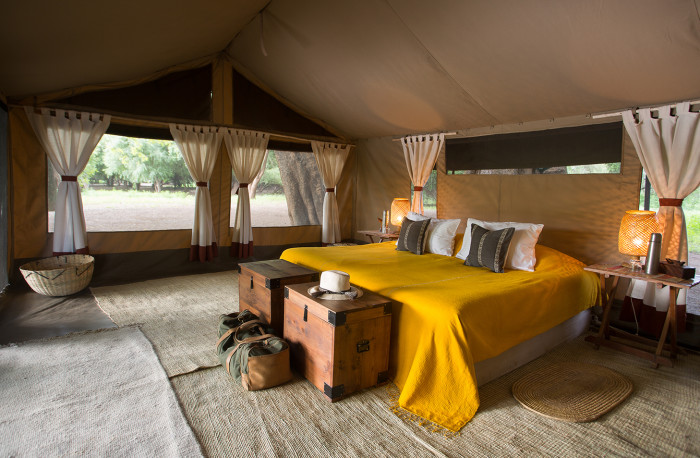
Elsewhere, closer to the bigger towns, villagers are charging visitors to attend bull-jumping ceremonies. A young boy I met in a Hamar village who took a fancy to my cap had already mastered the English for “give me”. Even Lemon seemed resigned to the fact that the visits he helped organise, however limited the numbers and respectful the guests, were part of the changes that were sweeping through the valley.
Some disappearing traditions are not to be lamented. Until recently, Kara children born out of wedlock were considered “cursed” and left outside to die or thrown into the Omo River. Lemon says infanticide has stopped, largely through outside influence.
Back in Dus, as dusk settled, the village had gathered for a dance. Some of the men, painted in their most lavish designs, sported trilby hats worn at a jaunty angle. Many gathered in a large circle, dancing and singing. Young women, their hair plastered in ochre and butter, swayed as the men competed to jump highest. Though everything was unfamiliar, from the paint to the music, the atmosphere resembled nothing more than an English village dance around the maypole.
Standing there on that beautiful evening, quite ignored by the villagers who were having far too much fun to notice us, was like witnessing a fading photograph. This was the world until yesterday. For a few short years, and for a privileged few, it can still be seen today.
Details
David Pilling was a guest of Steppes Travel (steppestravel.com). A five-night trip costs from £3,650 per person, including four nights in the Omo Valley on a full-board basis, one night in Addis Ababa, domestic flights and guiding. Flights from London would add around £600
David Pilling is the FT’s Africa editor
Follow @FTLifeArts on Twitter to find out about our latest stories first. Subscribe to FT Life on YouTube for the latest FT Weekend videos
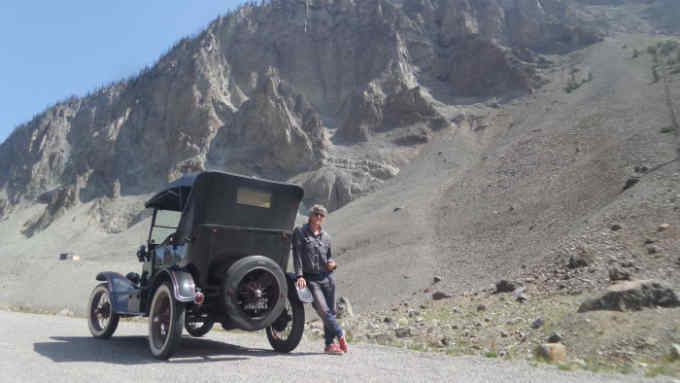
Comments